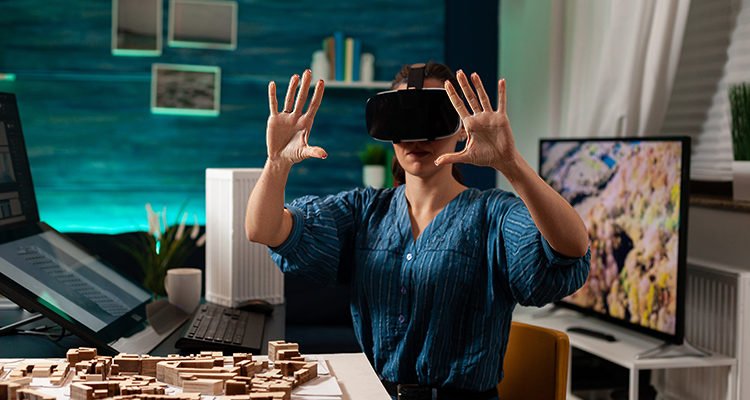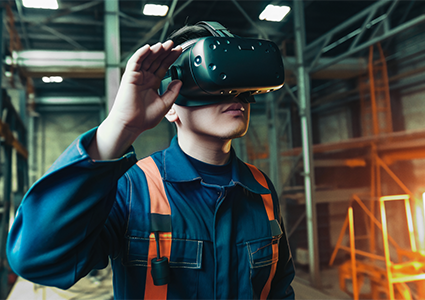
How the metaverse is improving efficiency within the construction industry. By Dr. Harpreet Seth
The metaverse is at the forefront of discussions across several different business sectors. A concept born out of the internet age, it is considered a distant and scary place to explore.
But the term has been around since 1992, when Neal Stephenson mentioned it in the novel Snow Crash. In the novel Hiro, the protagonist, moves in and out of a place called the metaverse, a computer-generated urban landscape where users can have real life-like experiences.
Construction in the metaverse
 Up until now, the metaverse has not been synonymous with the construction sector. However, the increasing possibilities to visualise, share concepts, and realise the finished structure both from an interior and external perspective has been game changing.
Up until now, the metaverse has not been synonymous with the construction sector. However, the increasing possibilities to visualise, share concepts, and realise the finished structure both from an interior and external perspective has been game changing.
As one of the fastest-growing industries, the construction sector stands to gain from the metaverse in the future and not just the core industry, but also designers, architects, and project managers. Increase in the use of metaverse technologies will help designers and architects create spaces in an increasingly efficient manner.
3D visualisation has been commonplace in construction for some time but it’s ready to take the next step and enter the metaverse. In the near future 3D VR and AV visualisation tools, such as those deployed in the metaverse sphere, will be integrated into each phase of a construction project – from conception, and ongoing monitoring to finalising the site.
Combining the physical and virtual
It is imperative to understand the importance of the metaverse at all three stages of construction: design, development, and build. In these stages, the concept provides a near-real feel of the end product through AR and VR.
For instance, an architect could design a building in Scotland, while the client reviews the CADs in Dubai, so a pre-build phase becomes a multisensory experience. Virtual representations of buildings can also demonstrate new and innovative ideas all without the added cost and environmental impact of transport costs.
Architects and designers are intrinsic to creating spaces in the virtual environment, from designing indoor to outdoor spaces, which they also handle in the physical world.
Moving onto the next stage in the building process, the metaverse allows construction project managers to live in the space as it is being developed, to virtually walk through the rooms as they build around them. While they cannot be present at every meeting or site visit, they can keep an eye on everything happening at the build stage with the help of these virtual representations.
On the engineering side, the metaverse can help ensure all of a building’s operational systems, from ventilation and heating to lighting and security, are fully integrated. These are called ‘smart buildings’ and are essential in the drive towards achieving net zero.
Potential challenges in the metaverse
It will not be long before all things in the physical world will be given a virtual representation, blurring the boundaries of the physical and digital even further. A project imagined and viewed in a virtual world may look quite different to what is finally delivered in the real world.
project imagined and viewed in a virtual world may look quite different to what is finally delivered in the real world.
There are also the inevitable data privacy issues and questions over ownership. Who owns a virtual asset, for example? Does a company which owns a building in the real world also own its representation in the virtual world? Do they enjoy the same level of property protection and legal coverage? These are questions lawyers and ethicists are debating right now and it’s a complex area.
We are also at the early stage of the metaverse and the construction industry coming together, which brings high costs. Currently, the use of metaverse in construction is being realised in luxury and high-end projects. With each passing day, however, this trend is expected to change due to research and development.
Next generation
At Heriot-Watt University Dubai, experts in construction and computer technology have worked together to develop an Immersive Hybrid Reality (IHR) construction tool using the metaverse to improve efficiency within the construction industry.
This gives students an opportunity to learn using the latest technology, including AR and VR, and encourages an environment where academia and industry can come together to find solutions to all sorts of problems. The evolution is rapid, as an increasing number of PhD research candidates are taking on the complexities of the technology.
Meanwhile, at Heriot-Watt University in Edinburgh, a dedicated incubator known as the Imagineering Suite fosters start-ups, spinouts, and entrepreneurs to co-locate and encourage their creative ideas to flourish. The immersive facilities help build digital twins to reduce risk and accelerate the adoption of new technology.
Students leaving the university will be skilled in using the tools of the metaverse, ready to take their fresh ideas and energy into industries keen to support their ambitions.
For a list of the sources used in this article, please contact the editor. Seth
www.hw.ac.
Dr. Harpreet Seth is Head of Architecture at Heriot-Watt University Dubai. The Heriot-Watt University is a global research-led university based in the UK, with five campuses in Edinburgh, the Scottish Borders, Orkney, Dubai and Malaysia. The Enterprise division of Heriot-Watt University is focused on pioneering global research which solves social and economic problems in close collaboration with industry.